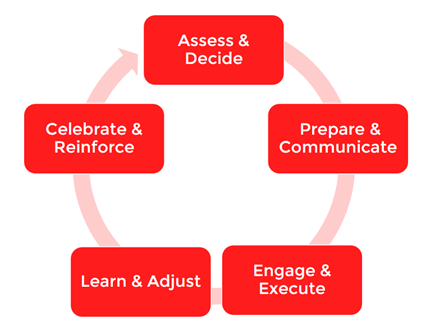Just because we’ve carefully planned and communicated our change project doesn’t mean it will go as planned. How do we stay focused and continue to shepherd these projects through to successful completion? How do we keep change projects on track?
This article is part of our Change Management series. For more information about this series visit our Change Resources page.
In a previous article in this series, we introduced the Results Change Model and did a deep dive into the first two phases: Assess and Decide, and Prepare and Communicate.
Here, we’ll explore the following three phases:
- Engage and Execute
- Learn and Adjust
- Celebrate and reinforce

Engage and Execute
Organizations can’t stop everything to implement a change. A good analogy is to think of organization change like redesigning an airplane – while it’s in the air! This requires careful planning to ensure that the change project does not cause business interruption.
Note that change moves through a transition stage where there may be a need for extra effort and resources, redundant systems, and plenty of openness and communication. Leaders must continue to listen and reinforce, and be on the watch for resistance that can undermine the process.
Another common misconception is treating a change project like any other project. This is only partially true. Yes, change initiatives can benefit from project management techniques and approaches, but we recommend adding a parallel change management stream.
Deanna Williams explains the value of adding a Change Management Stream
Your priorities for guiding change as a leader should include these additional activities and roles:
- An assigned change leader or champion, separate from the project manager.
- A continued focus on how people are navigating the change valley. Is there resistance? How are they struggling?
- Continuous interaction with employees through the entire process and well into adoption - keeping them informed, making them feel safe, and addressing their concerns.
- Planning and executing training for the new skills and tools needed when the desired future state is reached.
- Calculation and comparison of the expected versus achieved results of the change.
- Ongoing sensing for threats and opportunities that may require course corrections.
- Coordinating and communicating mid-point wins through the process.
- Regular communication between the change champion, senior leaders, and the project manager.

Learn and Adjust
Rarely does any project go exactly as planned. We must be ready to course correct based on feedback and new information. Any time an unexpected event presents itself, the team should regroup, assess the impact of the event, and adjust the plan. Depending on the scope of the event, this might even include rethinking the ‘why’ and the business case for the change project.
Many years ago, I was involved in a new product launch in the telecommunication industry. More than one year into the project we discovered that a competitor was planning to launch a new and BETTER product than our own. This forced us to revisit the business case for the change where we discovered that despite having already spent hundreds of thousands of dollars on the project, it didn’t make sense to carry on.
Celebrate and Reinforce
In our fast-paced lives its easy to jump from one problem or project to the next and forget about what we’ve achieved. If we don’t do this, we miss the opportunity to recognize employees, celebrate wins, and learn from the experience.
The US Navy SEALS use a technique called an After-Action Review following each mission. This structured questioning process provides for recognition and celebration of successes, as well as learning opportunities for things that didn’t go as well or as planned. As change is a constant, learning from each change project builds skill and know-how for subsequent initiatives.
And don’t underestimate the value of quick and ongoing wins. Highlighting quick wins maintains high engagement and momentum for the project.
Not all employees will move through change at the same rate. This Celebrate and Reinforce phase will highlight the leaders and encourage the laggers in adoption of the change.
Unleashing the Potential of Your Organization
In this series of articles, we have taken a deep dive into the topic of change. We’ve looked at common pitfalls, the process of change, the psychology of change for people, and a five-stage model for implementing change in your organization.
For complimentary access to the Results Leading Change Model make sure you download the Leading Change Template and use it for your next change initiative.
If you’d like to learn more about change or other ways you can take the simpler path to creating a great business, connect with us or consider attending one of our upcoming leadership events.




